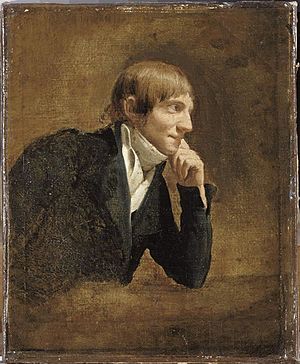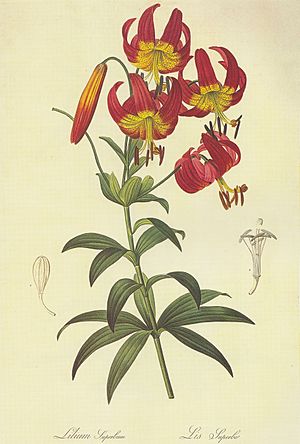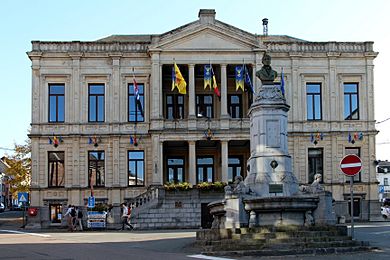Pierre-Joseph Redouté facts for kids
Quick facts for kids
Pierre-Joseph Redouté
|
|
|---|---|

Portrait by Louis Léopold Boilly
|
|
| Born | 10 July 1759 Saint-Hubert, Belgium
|
| Died | 19 June 1840 (aged 80) Paris, France
|
| Resting place | Père Lachaise Cemetery |
| Nationality | Belgian |
| Education | Jardin du Roi |
| Known for | Botanical illustration |
| Movement | Flower painting |
| Awards | Chevalier of the Légion d'honneur (1825) |
Pierre-Joseph Redouté (born July 10, 1759 – died June 19, 1840) was a famous painter and botanist from Belgium. He was best known for his beautiful watercolor paintings of roses, lilies, and many other flowers. His detailed artworks were often turned into large, colored prints. People called him "the Raphael of flowers" because he was so talented. Many consider him the greatest botanical artist ever.
Redouté was an official artist for Marie Antoinette, who was the Queen of France. He kept painting even during the difficult times of the French Revolution. He became famous around the world for his very accurate plant drawings. These drawings still look amazing today, just as they did when he first painted them. He was not only a great artist but also had a friendly personality. This helped him get support from important people. After Queen Marie-Antoinette, he worked for Empress Joséphine and Marie Louise, Duchess of Parma, who were both wives of Napoleon. He also worked for Maria Amalia of Naples and Sicily, the wife of Louis Philippe I, the last king of France.
Redouté worked with the best plant scientists of his time. He helped create almost fifty books that showed flowers from the French court and plants from far-off places like Japan, America, South Africa, and Australia. He always painted from live plants, not dried ones. This made his drawings look very fresh and real. He created more than 2,100 published pictures, showing over 1,800 different plant species. Many of these plants had never been drawn before. Today, Redouté is still the most well-known French botanical artist. He is seen as a successor to famous Flemish and Dutch flower painters like Brueghel and Ruysch.
Contents
Early Life and Artistic Beginnings
Pierre-Joseph Redouté was born on July 10, 1759, in Saint-Hubert, Belgium. His father and grandfather were both painters. His older brother, Antoine Ferdinand, worked as an interior decorator and designed theater sets. Pierre-Joseph did not get much formal schooling. Instead, he left home at 13 to work as a traveling painter. He painted interiors, portraits, and religious scenes.
In 1782, he moved to Paris to join his brother. There, he helped paint scenery for theaters.
Becoming a Botanical Artist
In Paris, Redouté met two plant scientists, Charles Louis L'Héritier de Brutelle and René Desfontaines. They encouraged him to try botanical illustration, which was a growing field. L'Héritier became his teacher. He taught Redouté how to carefully study flowers and draw their exact features. L'Héritier also introduced Redouté to the royal court at Versailles. Soon after, Queen Marie Antoinette became his supporter. Redouté eventually received the title of "Draughtsman and Painter to the Queen's Cabinet."
A Parisian art dealer named Cheveau introduced Redouté to another botanical artist, Gerard van Spaendonck. Van Spaendonck worked at the Jardin du Roi, which later became the Jardin des plantes after the French Revolution. Van Spaendonck also became Redouté's teacher, especially helping him improve his watercolor skills.
In 1786, Redouté started working at the National Museum of Natural History. He helped list and organize their collections of plants and animals. He also joined trips to study plants in different places. In 1787, he traveled to the Royal Botanic Gardens, Kew near London to study plants there. He returned to France the next year. In 1792, the French Academy of Sciences hired him.
Working for Royalty and Famous Gardens

In 1798, Empress Joséphine de Beauharnais, who was the first wife of Napoleon Bonaparte, became his patron. A few years later, he became her official artist. In 1809, Redouté even taught painting to Princess Adélaïde of Orléans.
Empress Joséphine asked Redouté to paint plants from her garden at the Château de Malmaison in Paris. His famous book, Les Roses, is well-known. But his book Jardin de la Malmaison has a special connection to Australia. Out of 120 pictures in the book, 46 showed Australian plants. Most of these plants grew only in Queensland, Australia.
One of the first Australian plants Empress Joséphine chose for Redouté to draw was a common Queensland flowering vine. It was called Hardenbergia violacea, also known as false sarsaparilla. This vine grows a lot in the Australian bush. Other Queensland plants he drew included the Pandorea pandorana (wonga wonga vine), Melaleuca styphelioides (prickly-leaved paperbark), and Hibiscus heterophyllus (native rosella).
Later Life and Lasting Legacy

After Empress Joséphine passed away in 1814, Redouté had some difficult years. But in 1822, he was appointed a master of drawing for the National Museum of Natural History. In 1824, he started teaching drawing classes at the museum. Many of his students were from noble families or even royalty. In 1825, he was honored with the title of Chevalier of the Legion of Honour. Even though he was famous for his roses and lilies, he later created paintings just for their beauty.
Redouté continued to teach and paint until the day he died from a stroke on June 19 or 20, 1840. He was survived by his wife, Marie-Marte Gobert, whom he married in 1786, and their two daughters. He was buried in Père Lachaise Cemetery in Paris. A school in Brussels, Belgium, is named after him: the Institut Redouté-Peiffer.
Many of the original watercolor paintings from his book Les Liliacées went to Empress Joséphine's son, Eugène de Beauharnais. Most of the watercolors from her Jardin de la Malmaison book are now at the Fitzwilliam Museum in Cambridge, England.
The paintings Redouté made for Les Roses were bought by Charles X of France for his daughter-in-law. It's hard to track where all these paintings are now. Some were sold in London in 1948, and a few are at the Hunt Institute for Botanical Documentation. Single pages have also appeared for sale at auctions many times.
In 1985, an art dealer bought 468 of his original artworks at an auction in New York for about 5.5 million dollars. These were then sold off to different buyers.
In recent times, many exhibitions have been held in Europe, America, and Australia to show Redouté's work. Libraries like the Biodiversity Heritage Library and the Library of Congress have put many of his works online for everyone to see. You can also find copies of his prints in almost any art print shop.
Important Works
- Geraniologia (1787–88)
- Les Liliacées (1802–1816)
- Les Roses (1817–1824)
- Plantes grasses (1790)
- Choix des plus belles fleurs et de quelques branches des plus beaux fruits (1827)
- Alphabet Flore (1835)
Images for kids
See also
 In Spanish: Pierre-Joseph Redouté para niños
In Spanish: Pierre-Joseph Redouté para niños








